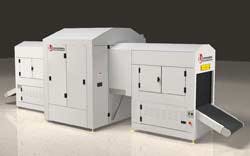L-3 Communications Announces National Rollout of Networked Explosives Detection Systems
L-3 Communications announced today that its subsidiary, L-3 Communications Security and Detection Systems, is deploying its networked explosives detection system (NEDS) for the eXaminer 3DXR 6000 at airports nationwide and internationally. The total value of these deployments is approximately $10 million. Additional future deployments are anticipated.
Following the completion of a successful Operational Utility Evaluation (OUE) by the TSA at Orange County California?s John Wayne Airport and further evaluation of a limited deployment by L-3 at Boston?s Logan International Airport, the U.S. Transportation Security Administration (TSA) has funded the installation of this advanced EDS networking capability at six major airports: Boston?s Logan International Airport, Pennsylvania?s Harrisburg International Airport, Las Vegas? McCarran International Airport, Baltimore?s Washington International Airport, Southwest Florida?s International Airport and Tampa International Airport (TPA).
L-3 Communications has already deployed its networked systems to airports in the United States and internationally. In addition, L-3 is a leader in the international market for certified EDS and has implemented advanced networking of its eXaminer systems at Singapore?s Changi Airport, and plans to have the capability installed at Israel?s Ben Gurion Airport by the end of this year.
?Networking in-line baggage screening systems lowers operating costs by eliminating the need to have a dedicated operator for each eXaminer,? said Allen Barber, senior vice president and general manager of L-3 Security and Detection Systems. ?With NEDS, the TSA and airports can more efficiently allocate screener resources during peak and non-peak hours, and minimize the time it takes to search suspect bags.?
The L-3 eXaminer?s unique 3-D imagery helps streamline manual searches. Though the majority of suspect bag alarms are resolved without interrupting their movement through the airport?s baggage handling system (BHS), a small number of bags need to be taken off-line and manually searched by security personnel. By networking the system, the eXaminer?s on-screen 3-D tools can be accessed by screeners at dedicated search workstations, so suspect items within a bag can be pinpointed, minimizing the time spent searching its contents and allowing the bag to be quickly reintroduced to the BHS. This results in speeding bags to planes.
The eXaminer 3DXR 6000 is certified by the TSA to screen aviation checked baggage. More than 500 of the high technology systems are deployed throughout the world, with eight major airports using in-line networked configurations. Airports implementing NEDS have recorded throughput rates as high as 560 bags per hour for an eXaminer 3DXR 6000 system, when the BHS is optimized as part of an overall integrated system tailored to the operational parameters of the EDS.
The eXaminer 3DXR 6000
. Provides a rapid, complete 3-D image for analysis by operators of alarmed bags, resulting in unmatched on-screen resolution (OSR) time, further improving efficiencies and speeding bags to planes.
. Competing systems provide only 2 dimensional X-ray images and fewer overall views of suspect bags.
. Certified by the TSA for both the original requirement of 100 percent threat mass as well as the more stringent 75 percent threat mass.
. Performs at the lowest average false alarm rate in the industry measured across all of the airports where systems are deployed.
